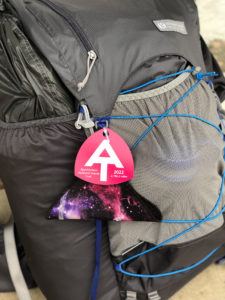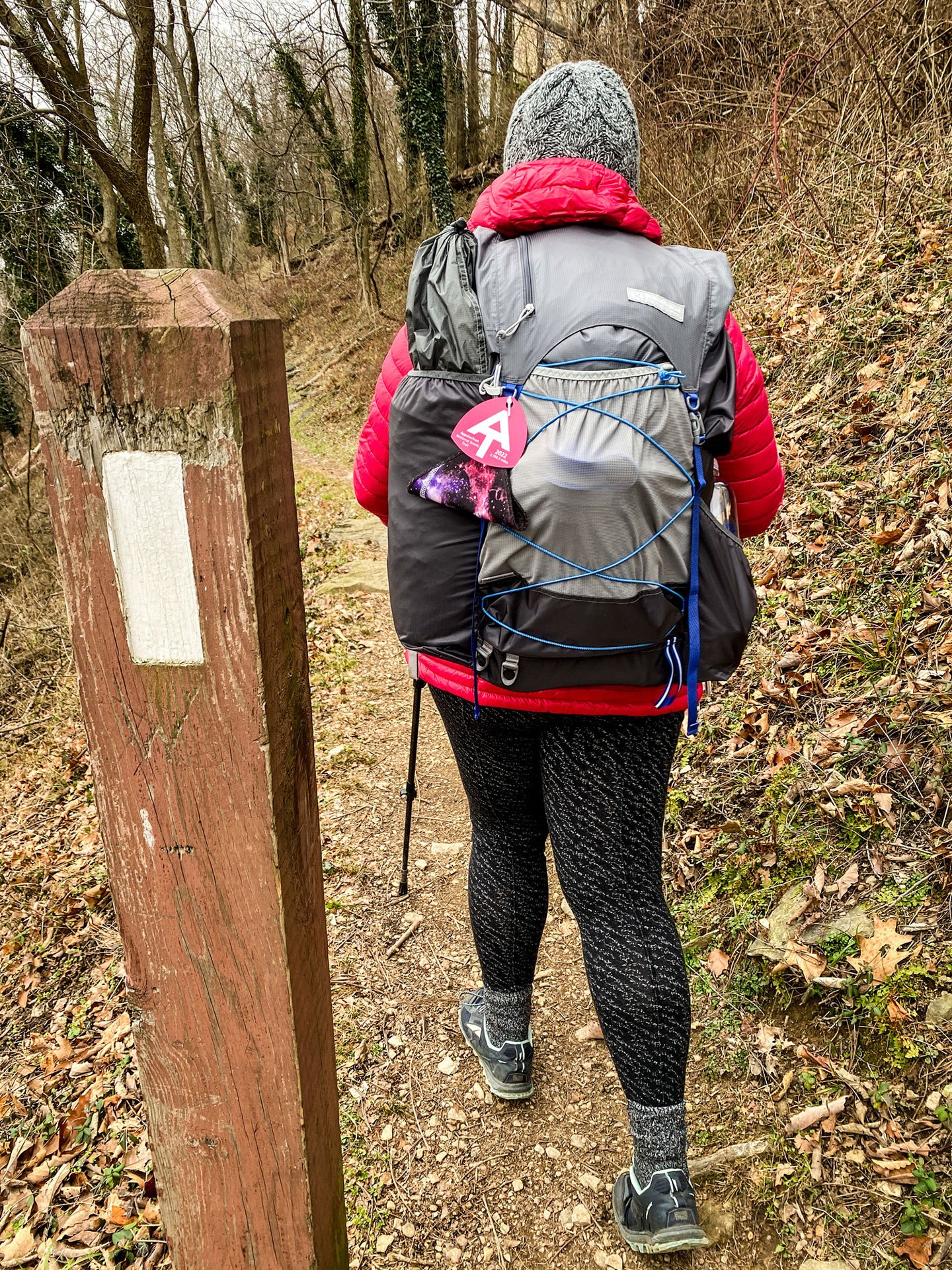2,000-MILERS
A.T. Hangtags
Hangtags distributed by the Appalachian Trail Conservancy (ATC) are frequently seen dangling off an aspiring 2,000-miler’s pack, marking their intent to traverse the entire Appalachian Trail (A.T.). Since hangtags have become so popular with thru-hikers and section hikers, we wanted to address some frequently asked questions about the A.T. hangtags.
What are A.T. hangtags?
 The A.T. hangtags distributed by the ATC are designed to hang from a hiker’s backpack during their attempts to complete all 2,190+ miles of the Trail, whether in one continuous thru-hike or over a series of section hikes. The front features the A.T. logo and the year. The back provides Leave No Trace information and a blank area where hikers can personalize the tags with a registration number, Trail name, or other information. The hang tags are in the shape of an elliptical triangle, the same shape as the Appalachian National Scenic Trail logo.
The A.T. hangtags distributed by the ATC are designed to hang from a hiker’s backpack during their attempts to complete all 2,190+ miles of the Trail, whether in one continuous thru-hike or over a series of section hikes. The front features the A.T. logo and the year. The back provides Leave No Trace information and a blank area where hikers can personalize the tags with a registration number, Trail name, or other information. The hang tags are in the shape of an elliptical triangle, the same shape as the Appalachian National Scenic Trail logo.
The ATC developed the A.T. hangtags in 2015 when the voluntary thru-hiker registration program began, now known as ATCamp. Registering your hike on ATCamp helps hikers choose less crowded starting dates for their hikes, which helps reduce overcrowding and the subsequent damage to the Trail and its surrounding environment.
What is the purpose of the A.T. hangtags?
The primary purpose of the A.T. hangtag is to promote sustainable hiking practices aligned with Leave No Trace principles. Hangtags also provide a way for hikers to celebrate their thru-hikes and section hikes of the A.T.
Who is eligible to receive a hangtag?
Anyone who has registered an A.T. thru-hike on ATCamp is eligible for a hangtag. Section-hikers who have the goal of hiking the entire A.T. who have registered their hikes on ATCamp are also eligible.

Where can someone get a hangtag?
A.T. hangtags are distributed in person after a brief discussion about Leave No Trace principles on the Trail. Hikers can pick up their hangtags each year at the following locations:
- A.T. Visitor Center, Monson, Maine (June – October)
- ATC Headquarters and Visitor Center, Harpers Ferry, West Virginia
- Damascus Trail Center, Damascus, Virginia
- Amicalola Falls State Park, Dawsonville, Georgia
When are hangtags available each year?
The ATC tries to make hangtags available as soon as possible after the new year and they are typically available starting in early February (except in Monson, where the visitor center does not open for the season until June). Hikers should not expect hangtags to be available on the first of the year.
The ATC cannot print new hangtags until we have the final, official Trail mileage for the coming year, which is often not released until December to give A.T. Clubs and partners time to complete calculations. The hangtags also take several weeks to print and ship.
Learn more about why the Trail’s length changes each year.
Can you mail me a hangtag?
A.T. hangtags are only distributed in person to the person who has registered on ATCamp. We do not mail current-year A.T. hangtags. If you are unable to get a hangtag in person during your hike, you can wait until the end of the season when current-year hangtags will be posted in the Ultimate A.T. Store®.
What’s the deal with hiker numbers on the hangtags?
Hiker hangtag numbers are largely ceremonial. While registration numbers at places like Amicalola Falls State Park, the ATC’s Harpers Ferry Visitor Center, and Baxter State Park are used by the ATC and partners to understand visitation trends (and in case of emergency at Amicalola), hangtag numbers are not used in any other official capacity by the ATC.
Hiker numbers are given out at both Amicalola Falls State Park for NOBO hikers as part of hiker registration there and at the ATC’s Harpers Ferry Visitor Center when hikers get their iconic photo taken with the ATC sign. These numbers are different from ATCamp registration numbers, which are assigned by ATCamp when registration is completed.
Hikers starting at Amicalola are required to sign the park’s register in case of emergency. When a hiker registers, they are given a number based on how many other hikers have already signed in. For example, a hiker with the number 150 was the 150th northbound hiker to start that year from the park.
Numbers are given out in a similar way at the ATC’s Harpers Ferry Visitor Center. For example, a flip-flopper could also have number 150 if they were the 150th flip-flop hiker to stop at the visitor center that year. Or, if a NOBO hiker did not get a number (for instance if they started at Springer rather than at Amicalola), they could get a number at Harpers Ferry based on how many other NOBOs have already come through. So, in theory, there could be several hikers with the same number!
Numbers are not given out at the Damascus Trail Center or Monson Visitor Center.
Putting a number on hangtags has become a tradition over the last several years and can be a nice way for hikers to track their progress on the Trail.
Discover More

Plan and Prepare
Thru-Hiking
Thru-hiking the A.T. is the adventure of a lifetime. But trekking the 2,190+ miles of the A.T. is no easy feat — make sure you’re prepared!

Plan and Prepare
Register Your Hike on ATCamp
In addition to reserving your A.T. Hangtag, registering your hike on ATCamp can help prevent crowding and preserve the Appalachian Trail hiking experience.

Plan and Prepare
Hiker Resource Library
A collection of resources for hikers to stay safe, healthy, and responsible on the Appalachian Trail.





